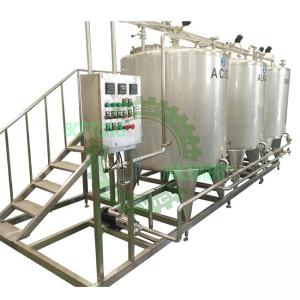Fully automatic CIP cleaning system structure:
1. Acid tank: SUS304, volume 500-3000L, etc., can be customized according to customer requirements;
2. Alkali tank: SUS304, volume 500-3000L, etc., can be customized according to customer requirements;
3. Water tank: SUS304, volume 500-3000L, etc., can be customized according to customer requirements;
4. Process pump, return pump, conversion plate, plate heat exchanger, semi-automatic control box, operating platform, pipeline valve.
Taking the beverage industry as an example, the cleaning procedures are as follows:
1. Washing for 3-5 minutes, normal temperature or hot water above 60℃; alkaline washing for 10-20 minutes, 1%-2% solution, 60℃-80℃; intermediate washing for 5-10 minutes, washing with water below 60℃3- 5 minutes, clean water.
2. Washing for 3-5 minutes, normal temperature or hot water above 60℃; alkaline washing for 5-10 minutes, 1%-2% solution, 60℃-80℃, intermediate washing for 5-10 minutes, clean water below 60℃, sterilization 10 —20 minutes, hot water above 90℃.
Cleaning flow: The guarantee of the flow is actually to ensure the flow rate of the cleaning liquid during cleaning, thereby generating a certain mechanical effect, that is, improving the impact force by improving the turbulence of the fluid and achieving a certain cleaning effect.
CIP cleaning effect evaluation standard As an ideal CIP in the food industry, the cleaning effect must meet the following standards:
1. Smell: fresh, no peculiar smell, slight smell is allowed for special treatment process or special stage, but does not affect the safety and quality of the final product.
2. Vision: The cleaning surface is bright, no water, no film, no dirt or other. At the same time, after the CIP treatment, the production capacity of the equipment changes significantly. The microbiological index of the hygiene index meets the relevant requirements; it cannot cause the improvement of other hygiene indexes of the product. Cost is an important factor to measure the cleaning effect when the economy can meet the cleaning conditions at the same time. CIP operation must be relatively safe and convenient. With the continuous improvement of the mechanization and automation of food production, the CIP system has been extensively researched and applied, and at the same time, scientific progress and continuous market regulation, its popularity in food production will continue to increase.
1. Purpose: Standardize the CIP cleaning operation procedures, maintain equipment, and ensure continuous and normal production.
2. Scope of application: CIP cleaning section.
3.Content:
3.1 Cleaning sequence: clean water at 40℃, 2% alkali, clean water at 40℃, 0.8% acid, hot water above 90℃, wash in sequence.
3.2 Clean and record at the specified time.
3.3 Add about 80% of the water, that is, cover the heating coil.
3.4 Acid-base concentration:
3.4.1 Check the concentration before cleaning, if it is not enough, add an appropriate amount.
3.4.2 According to the degree of acid-base pollution, decide whether to re-formulate.
3.5 Connect the inlet and outlet distributors correctly.
3.6 Check the water delivery device from time to time to prevent blockage.
3.7 After checking the pipelines and valves, the centrifugal pump can be started for cleaning.
3.8 When cleaning with acid and alkali, after cleaning, turn on the reflux pump to allow the acid and alkali to flow into the acid tank and the alkali tank respectively.
3.9 Rinse with clean water, and the cleaning is complete.
3.10 Use the test paper to test it to be neutral.


